Bettina Könighofer
Fairness Shields: Safeguarding against Biased Decision Makers
Dec 16, 2024



Abstract:As AI-based decision-makers increasingly influence human lives, it is a growing concern that their decisions are often unfair or biased with respect to people's sensitive attributes, such as gender and race. Most existing bias prevention measures provide probabilistic fairness guarantees in the long run, and it is possible that the decisions are biased on specific instances of short decision sequences. We introduce fairness shielding, where a symbolic decision-maker -- the fairness shield -- continuously monitors the sequence of decisions of another deployed black-box decision-maker, and makes interventions so that a given fairness criterion is met while the total intervention costs are minimized. We present four different algorithms for computing fairness shields, among which one guarantees fairness over fixed horizons, and three guarantee fairness periodically after fixed intervals. Given a distribution over future decisions and their intervention costs, our algorithms solve different instances of bounded-horizon optimal control problems with different levels of computational costs and optimality guarantees. Our empirical evaluation demonstrates the effectiveness of these shields in ensuring fairness while maintaining cost efficiency across various scenarios.
Test Where Decisions Matter: Importance-driven Testing for Deep Reinforcement Learning
Nov 12, 2024



Abstract:In many Deep Reinforcement Learning (RL) problems, decisions in a trained policy vary in significance for the expected safety and performance of the policy. Since RL policies are very complex, testing efforts should concentrate on states in which the agent's decisions have the highest impact on the expected outcome. In this paper, we propose a novel model-based method to rigorously compute a ranking of state importance across the entire state space. We then focus our testing efforts on the highest-ranked states. In this paper, we focus on testing for safety. However, the proposed methods can be easily adapted to test for performance. In each iteration, our testing framework computes optimistic and pessimistic safety estimates. These estimates provide lower and upper bounds on the expected outcomes of the policy execution across all modeled states in the state space. Our approach divides the state space into safe and unsafe regions upon convergence, providing clear insights into the policy's weaknesses. Two important properties characterize our approach. (1) Optimal Test-Case Selection: At any time in the testing process, our approach evaluates the policy in the states that are most critical for safety. (2) Guaranteed Safety: Our approach can provide formal verification guarantees over the entire state space by sampling only a fraction of the policy. Any safety properties assured by the pessimistic estimate are formally proven to hold for the policy. We provide a detailed evaluation of our framework on several examples, showing that our method discovers unsafe policy behavior with low testing effort.
Safety Shielding under Delayed Observation
Jul 05, 2023Abstract:Agents operating in physical environments need to be able to handle delays in the input and output signals since neither data transmission nor sensing or actuating the environment are instantaneous. Shields are correct-by-construction runtime enforcers that guarantee safe execution by correcting any action that may cause a violation of a formal safety specification. Besides providing safety guarantees, shields should interfere minimally with the agent. Therefore, shields should pick the safe corrective actions in such a way that future interferences are most likely minimized. Current shielding approaches do not consider possible delays in the input signals in their safety analyses. In this paper, we address this issue. We propose synthesis algorithms to compute \emph{delay-resilient shields} that guarantee safety under worst-case assumptions on the delays of the input signals. We also introduce novel heuristics for deciding between multiple corrective actions, designed to minimize future shield interferences caused by delays. As a further contribution, we present the first integration of shields in a realistic driving simulator. We implemented our delayed shields in the driving simulator \textsc{Carla}. We shield potentially unsafe autonomous driving agents in different safety-critical scenarios and show the effect of delays on the safety analysis.
Analyzing Intentional Behavior in Autonomous Agents under Uncertainty
Jul 04, 2023Abstract:Principled accountability for autonomous decision-making in uncertain environments requires distinguishing intentional outcomes from negligent designs from actual accidents. We propose analyzing the behavior of autonomous agents through a quantitative measure of the evidence of intentional behavior. We model an uncertain environment as a Markov Decision Process (MDP). For a given scenario, we rely on probabilistic model checking to compute the ability of the agent to influence reaching a certain event. We call this the scope of agency. We say that there is evidence of intentional behavior if the scope of agency is high and the decisions of the agent are close to being optimal for reaching the event. Our method applies counterfactual reasoning to automatically generate relevant scenarios that can be analyzed to increase the confidence of our assessment. In a case study, we show how our method can distinguish between 'intentional' and 'accidental' traffic collisions.
Learning Environment Models with Continuous Stochastic Dynamics
Jun 29, 2023



Abstract:Solving control tasks in complex environments automatically through learning offers great potential. While contemporary techniques from deep reinforcement learning (DRL) provide effective solutions, their decision-making is not transparent. We aim to provide insights into the decisions faced by the agent by learning an automaton model of environmental behavior under the control of an agent. However, for most control problems, automata learning is not scalable enough to learn a useful model. In this work, we raise the capabilities of automata learning such that it is possible to learn models for environments that have complex and continuous dynamics. The core of the scalability of our method lies in the computation of an abstract state-space representation, by applying dimensionality reduction and clustering on the observed environmental state space. The stochastic transitions are learned via passive automata learning from observed interactions of the agent and the environment. In an iterative model-based RL process, we sample additional trajectories to learn an accurate environment model in the form of a discrete-state Markov decision process (MDP). We apply our automata learning framework on popular RL benchmarking environments in the OpenAI Gym, including LunarLander, CartPole, Mountain Car, and Acrobot. Our results show that the learned models are so precise that they enable the computation of policies solving the respective control tasks. Yet the models are more concise and more general than neural-network-based policies and by using MDPs we benefit from a wealth of tools available for analyzing them. When solving the task of LunarLander, the learned model even achieved similar or higher rewards than deep RL policies learned with stable-baselines3.
Online Shielding for Reinforcement Learning
Dec 04, 2022Abstract:Besides the recent impressive results on reinforcement learning (RL), safety is still one of the major research challenges in RL. RL is a machine-learning approach to determine near-optimal policies in Markov decision processes (MDPs). In this paper, we consider the setting where the safety-relevant fragment of the MDP together with a temporal logic safety specification is given and many safety violations can be avoided by planning ahead a short time into the future. We propose an approach for online safety shielding of RL agents. During runtime, the shield analyses the safety of each available action. For any action, the shield computes the maximal probability to not violate the safety specification within the next $k$ steps when executing this action. Based on this probability and a given threshold, the shield decides whether to block an action from the agent. Existing offline shielding approaches compute exhaustively the safety of all state-action combinations ahead of time, resulting in huge computation times and large memory consumption. The intuition behind online shielding is to compute at runtime the set of all states that could be reached in the near future. For each of these states, the safety of all available actions is analysed and used for shielding as soon as one of the considered states is reached. Our approach is well suited for high-level planning problems where the time between decisions can be used for safety computations and it is sustainable for the agent to wait until these computations are finished. For our evaluation, we selected a 2-player version of the classical computer game SNAKE. The game represents a high-level planning problem that requires fast decisions and the multiplayer setting induces a large state space, which is computationally expensive to analyse exhaustively.
Automata Learning meets Shielding
Dec 04, 2022Abstract:Safety is still one of the major research challenges in reinforcement learning (RL). In this paper, we address the problem of how to avoid safety violations of RL agents during exploration in probabilistic and partially unknown environments. Our approach combines automata learning for Markov Decision Processes (MDPs) and shield synthesis in an iterative approach. Initially, the MDP representing the environment is unknown. The agent starts exploring the environment and collects traces. From the collected traces, we passively learn MDPs that abstractly represent the safety-relevant aspects of the environment. Given a learned MDP and a safety specification, we construct a shield. For each state-action pair within a learned MDP, the shield computes exact probabilities on how likely it is that executing the action results in violating the specification from the current state within the next $k$ steps. After the shield is constructed, the shield is used during runtime and blocks any actions that induce a too large risk from the agent. The shielded agent continues to explore the environment and collects new data on the environment. Iteratively, we use the collected data to learn new MDPs with higher accuracy, resulting in turn in shields able to prevent more safety violations. We implemented our approach and present a detailed case study of a Q-learning agent exploring slippery Gridworlds. In our experiments, we show that as the agent explores more and more of the environment during training, the improved learned models lead to shields that are able to prevent many safety violations.
Correct-by-Construction Runtime Enforcement in AI -- A Survey
Aug 30, 2022Abstract:Runtime enforcement refers to the theories, techniques, and tools for enforcing correct behavior with respect to a formal specification of systems at runtime. In this paper, we are interested in techniques for constructing runtime enforcers for the concrete application domain of enforcing safety in AI. We discuss how safety is traditionally handled in the field of AI and how more formal guarantees on the safety of a self-learning agent can be given by integrating a runtime enforcer. We survey a selection of work on such enforcers, where we distinguish between approaches for discrete and continuous action spaces. The purpose of this paper is to foster a better understanding of advantages and limitations of different enforcement techniques, focusing on the specific challenges that arise due to their application in AI. Finally, we present some open challenges and avenues for future work.
Search-Based Testing of Reinforcement Learning
May 14, 2022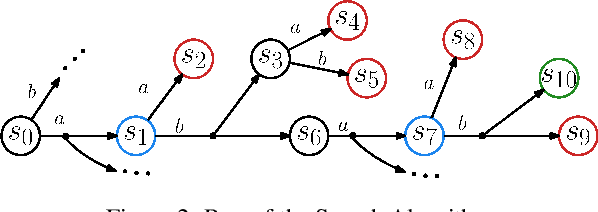
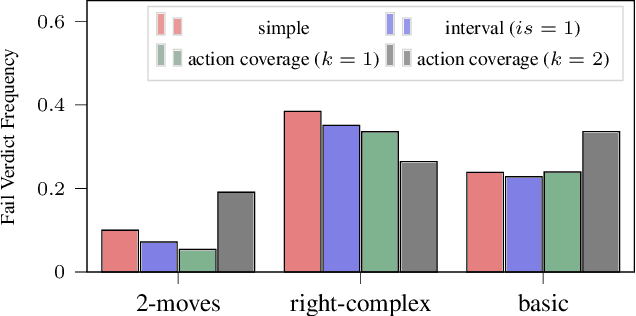
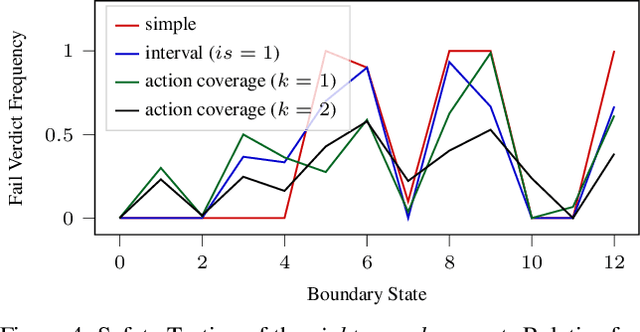
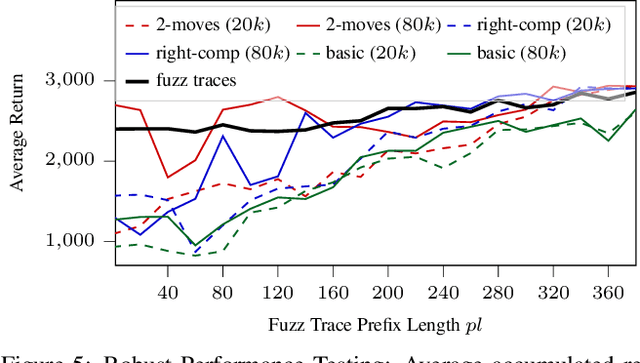
Abstract:Evaluation of deep reinforcement learning (RL) is inherently challenging. Especially the opaqueness of learned policies and the stochastic nature of both agents and environments make testing the behavior of deep RL agents difficult. We present a search-based testing framework that enables a wide range of novel analysis capabilities for evaluating the safety and performance of deep RL agents. For safety testing, our framework utilizes a search algorithm that searches for a reference trace that solves the RL task. The backtracking states of the search, called boundary states, pose safety-critical situations. We create safety test-suites that evaluate how well the RL agent escapes safety-critical situations near these boundary states. For robust performance testing, we create a diverse set of traces via fuzz testing. These fuzz traces are used to bring the agent into a wide variety of potentially unknown states from which the average performance of the agent is compared to the average performance of the fuzz traces. We apply our search-based testing approach on RL for Nintendo's Super Mario Bros.
It's Time to Play Safe: Shield Synthesis for Timed Systems
Jun 30, 2020
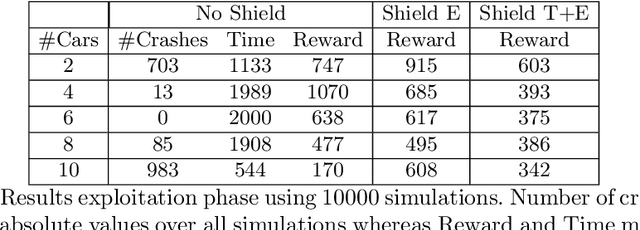
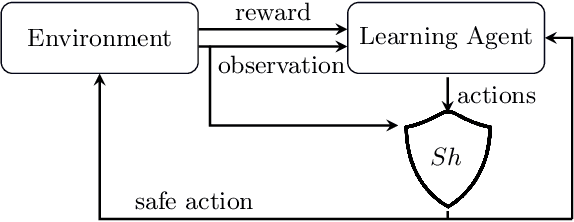

Abstract:Erroneous behaviour in safety critical real-time systems may inflict serious consequences. In this paper, we show how to synthesize timed shields from timed safety properties given as timed automata. A timed shield enforces the safety of a running system while interfering with the system as little as possible. We present timed post-shields and timed pre-shields. A timed pre-shield is placed before the system and provides a set of safe outputs. This set restricts the choices of the system. A timed post-shield is implemented after the system. It monitors the system and corrects the system's output only if necessary. We further extend the timed post-shield construction to provide a guarantee on the recovery phase, i.e., the time between a specification violation and the point at which full control can be handed back to the system. In our experimental results, we use timed post-shields to ensure the safety in a reinforcement learning setting for controlling a platoon of cars, during the learning and execution phase, and study the effect.
 Add to Chrome
Add to Chrome Add to Firefox
Add to Firefox Add to Edge
Add to Edge